Subscription purchases can go through several different states throughout their lifecycle, depending on many factors including auto-renewal behavior, payment decline situations, and developer management actions.
Handle lifecycle for auto-renewing subscriptions
When a user's subscription state changes, your backend server receives a
SubscriptionNotification message.

To update the state in your backend, call the
purchases.subscriptionsv2.get
API with the purchase token included in the notification. This endpoint provides
the latest subscription state given a purchase token and is considered the
source of truth for subscription management.
The purchase token is valid from subscription signup until 60 days after expiration. After this date, the purchase token is no longer valid to use to call the Google Play Developer API.
New auto-renewing subscription purchases
When a user purchases a subscription, a SubscriptionNotification message with
type SUBSCRIPTION_PURCHASED is sent to your RTDN client. Whether you receive
this notification or you register a new purchase in-app through
PurchasesUpdatedListener
or manually fetching purchases in your
app's onResume() method, you should process the new purchase in your secure
backend. To do this, follow these steps:
- Query the
purchases.subscriptionsv2.getendpoint to get a subscription resource that contains the latest subscription state. - Make sure that the value of the
subscriptionStatefield isSUBSCRIPTION_STATE_ACTIVE. - Verify the purchase.
- Give the user access to the content. The user account associated with the
purchase can be identified with the
ExternalAccountIdentifiersobject from the subscription resource if identifiers were set at purchase time usingsetObfuscatedAccountIdandsetObfuscatedProfileId.
The Play Billing Library also includes a method to acknowledge a subscription,
acknowledgePurchase(),
and a method to check acknowledgement status,
isAcknowledged().
However, we recommend that you handle purchase processing in your backend for
better security.
The subscription resource for new purchases looks similar to the following example:
{
"kind": "androidpublisher#subscriptionPurchaseV2",
"startTime": "2022-04-22T18:39:58.270Z",
"regionCode": "US",
"subscriptionState": "SUBSCRIPTION_STATE_ACTIVE",
"latestOrderId": "GPA.3333-4137-0319-36762",
"acknowledgementState": "ACKNOWLEDGEMENT_STATE_PENDING", // need to acknowledge new purchases
"lineItems": [
{
"productId": "sub_variant_plan01",
"expiryTime": next_renewal_date,
"autoRenewingPlan": {
"autoRenewEnabled": true
}
}
],
}
Subscription renewals
For non-installment, auto-renewing subscriptions, a SUBSCRIPTION_RENEWED
notification is sent when the subscription renews. For installment
subscriptions, a SUBSCRIPTION_RENEWED notification is sent each time the
subscription is charged on its billing date. Make sure that the user is still
entitled to the subscription and then update the subscription state with the new
expiryTime provided in the subscription
resource returned from the Google Play
Developer API. The subscription resource looks similar to the following example:
{
"kind": "androidpublisher#subscriptionPurchaseV2",
"startTime": "2022-04-22T18:39:58.270Z",
"regionCode": "US",
"subscriptionState": "SUBSCRIPTION_STATE_ACTIVE",
"latestOrderId": "GPA.3333-4137-0319-36762",
"acknowledgementState": "ACKNOWLEDGEMENT_STATE_ACKNOWLEDGED",
"lineItems": [
{
"productId": "sub_variant_plan01",
"expiryTime": next_renewal_date,
"autoRenewingPlan": {
"autoRenewEnabled": true
}
}
]
}
You don't need to acknowledge subscription renewals.
Grace period
If there are payment issues with a subscription renewal, Google notifies the user and periodically attempts to renew the subscription for some time before the subscription expires. This recovery period can consist of a grace period followed by an account hold period. During a grace period, the user should still have access to their subscription entitlement.
The
queryPurchasesAsync()
method continues to return purchases that are in the grace period. If your app
relies solely on queryPurchasesAsync to check whether a user is entitled to a
subscription, then your app should automatically handle grace periods, because
these subscriptions are shown as active through the Play Billing Library.
Synchronizing subscription state with your backend lets you to be more aware
of payment declines and gives you more context as you try to reduce involuntary
churn. Listen for
SubscriptionNotification messages
with type SUBSCRIPTION_IN_GRACE_PERIOD to be notified when the user enters a
grace period. While the user is in a grace period, the subscription
resource
contains autoRenewEnabled = true. Google Play dynamically extends the
expiryTime value until the grace period has expired because entitlement
should last until the user cancels or the grace period has lasted for its
maximum length. The value of the subscriptionState field during this period is
SUBSCRIPTION_STATE_IN_GRACE_PERIOD. The subscription resource looks similar to
the following example:
{
"kind": "androidpublisher#subscriptionPurchaseV2",
...
"subscriptionState": "SUBSCRIPTION_STATE_IN_GRACE_PERIOD",
...
"lineItems": [
{
"productId": "sub_variant_plan01",
"expiryTime": timestamp_in_future,
"autoRenewingPlan": {
"autoRenewEnabled": true
}
}
],
}
Play informs users that are in a grace period that their payment was declined and prompts them to fix their payment method issues in the Play Store. When a user enters a grace period, you should also encourage the user to fix their payment method in case the failure was involuntary. A straightforward way to do this is to use the In-App Messaging API. If you call this API when the user opens your app, they are shown a Play message in a temporary snackbar informing the user that their payment has been declined. This message also includes a deep link for the user to fix their payment method on Google Play.
As soon as the user fixes their payment method, the subscription renews with its original renewal date, and you can handle the renewal as described in Renewals.
If the user does not fix their payment method during the grace period, the subscription enters account hold, and they lose entitlement.
Grace period access and recovery
Figure 2 shows a timeline for a subscription that enters into a grace period and then recovers when the user fixes their payment method. After the grace period ends, the user should lose subscription benefits and go into account hold.

It is important to remember the following points:
- During a grace period, the user should retain access to subscription benefits.
- When a subscription recovers during a grace period, the renewal date does not reset.
- If you increase the grace period—for example, from 7 days to 14 days—users who are in a grace period get extended access to subscription benefits.
- If you decrease the grace period, users who are far enough into the old grace period to exceed the new grace period have their subscription benefits revoked immediately. For example, if you decrease the grace period from 14 days to 7 days, users who are in days 8-14 of the old grace period have their subscription benefits revoked immediately.
- The subscription remains in an active state and you won't receive a grace period RTDN until the silent grace period ends
Silent grace period
You can set a grace period of 0 days, but Play will wait a minimum of 1 day to
ensure sufficient time for payment retries. This silent grace period offers a
safety net for payment processing. During this 24‑hour period the
subscription remains in the
ACTIVE state.
The best way for you to stay in sync with subscription state changes is to
listen and react to the real-time developer notifications (RTDN). Call the
purchases.subscriptionsv2.get()
method at the RTDN time instead of the expiry time to get a more accurate
status of the subscription.
Depending on the subscription status after the 24‑hour silent grace period, you should receive one of the following notifications:
SUBSCRIPTION_ON_HOLD(if enabled)SUBSCRIPTION_CANCELED(if canceled)SUBSCRIPTION_EXPIRED(if expired)SUBSCRIPTION_RENEWED(if successfully renewed)
You can also call the subscriptionV2.get() method at any point after the
24‑hour silent grace period to get the latest status of the subscription.
Account hold
If there are payment issues with a subscription renewal, after any grace period has ended, an account hold period begins. When a subscription enters account hold, you should block access to the subscription entitlement.
During account hold, you should continue to handle any cancellations, restorations, or repurchases of your subscriptions as needed, because it's possible for the user to make these changes while the subscription is on hold.
RTDNs notify you when the user enters the account hold period, so you can inform them as soon as possible of why their access to the subscription was suspended. A straightforward way to do this is to use the In-App Messaging API. Calling this API when your user opens the app will show the user a message in a temporary snackbar informing them that their payment has been declined. This message also includes a deep link for the user to fix their payment method on Google Play.
If your users can access subscription content outside of your app, they might discover that they have lost access on different surfaces. You might want to send a push notification or an email to the user to let them know that their subscription is no longer active due to payment decline.
The subscription is not returned by the
queryPurchasesAsync()
method during account hold, so if your app relies on this method to display
existing purchases, you should support account hold by default.
With real-time developer
notifications, you receive a
SubscriptionNotification message
with type SUBSCRIPTION_ON_HOLD when a subscription enters account hold. Call
the
purchases.subscriptionsv2.get
method from your secure backend server to retrieve the new subscription
information. During account hold the expiryTime field of the subscription
resource
is set to a past timestamp, and the subscriptionState field is set to
SUBSCRIPTION_STATE_ON_HOLD:
{
"kind": "androidpublisher#subscriptionPurchaseV2",
...
"subscriptionState": "SUBSCRIPTION_STATE_ON_HOLD",
...
"lineItems": [
{
"productId": "sub_variant_plan01",
"expiryTime": timestamp_in_past,
...
}
],
}
To restore access, users must fix their payment method. Play informs users in account hold of their payment decline, and you should also encourage them to fix their payment method.
After the user fixes their payment method, the subscription returns to an active
state, and you must then restore access to the subscribed content. In this case,
the purchase token is the same as it was before the account hold started because
the same purchase is recovering, and you receive an RTDN with type
SUBSCRIPTION_RECOVERED.
For installment subscriptions, payment declines and recoveries could occur for any individual payment attempt.
After recovery, the Play Billing Library returns the subscription again through
the queryPurchasesAsync() method. If you use this method to determine whether
a user is entitled to a subscription, then your app should automatically handle
the subscription recovering from account hold.
Listen for a
SubscriptionNotification message
with type SUBSCRIPTION_RECOVERED to be notified when a subscription is
recovered and the user should regain access. If you query for a subscription
after receiving this notification, the expiryTime field is set to a timestamp
in the future and the subscriptionState field is set to
SUBSCRIPTION_STATE_ACTIVE again:
{
"kind": "androidpublisher#subscriptionPurchaseV2",
...
"subscriptionState": "SUBSCRIPTION_STATE_ACTIVE",
...
"lineItems": [
{
"productId": "sub_variant_plan01",
"expiryTime": next_renewal_date,
...
}
],
}
If the user does not fix their payment method before the end of the account hold
period, you instead receive an RTDN with type SUBSCRIPTION_CANCELED. For
instructions on handling a cancellation, see Cancellations. When you
query for a subscription that was canceled in this way, the returned
expiryTime field is set to a past timestamp:
{
"kind": "androidpublisher#subscriptionPurchaseV2",
...
"subscriptionState": "SUBSCRIPTION_STATE_CANCELED",
...
"lineItems": [
{
"productId": "sub_variant_plan01",
"expiryTime": timestamp_in_past,
...
}
],
}
Immediately after you are notified of the cancellation during account hold, you
will also receive an RTDN with type SUBSCRIPTION_EXPIRED because the user is
out of paid entitlement and the subscription has churned with the cancellation.
You can handle this expiration the way you normally would.
The user can regain access by repurchasing the same subscription plan or any
other plan that you offer through the app during their account hold period from
their original purchase. In that case, a new purchase token is issued and the
new value is returned as part of a SUBSCRIPTION_PURCHASED event that
represents this new instance.
Account hold access and recovery
Figure 3 shows a timeline for a subscription that enters into account hold and then recovers when the user fixes their payment method.
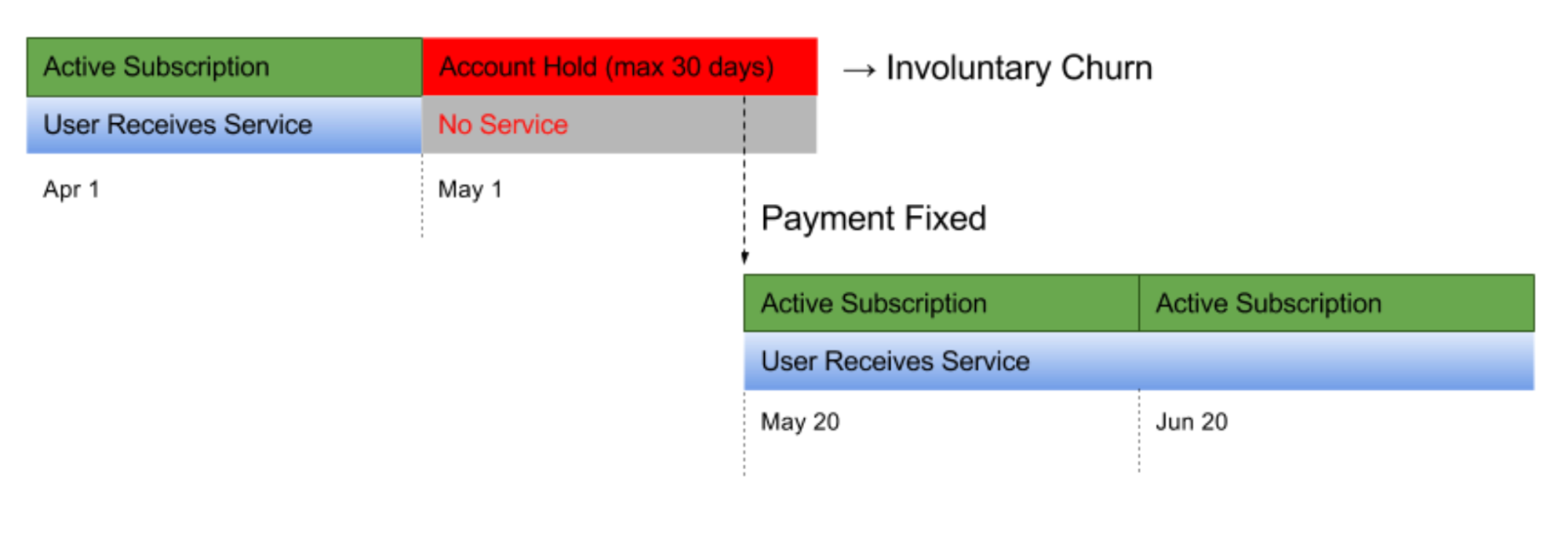
Similar to the previous example, Figure 4 shows a timeline for a subscription that first enters into a grace period before entering account hold, and then recovers while on hold.
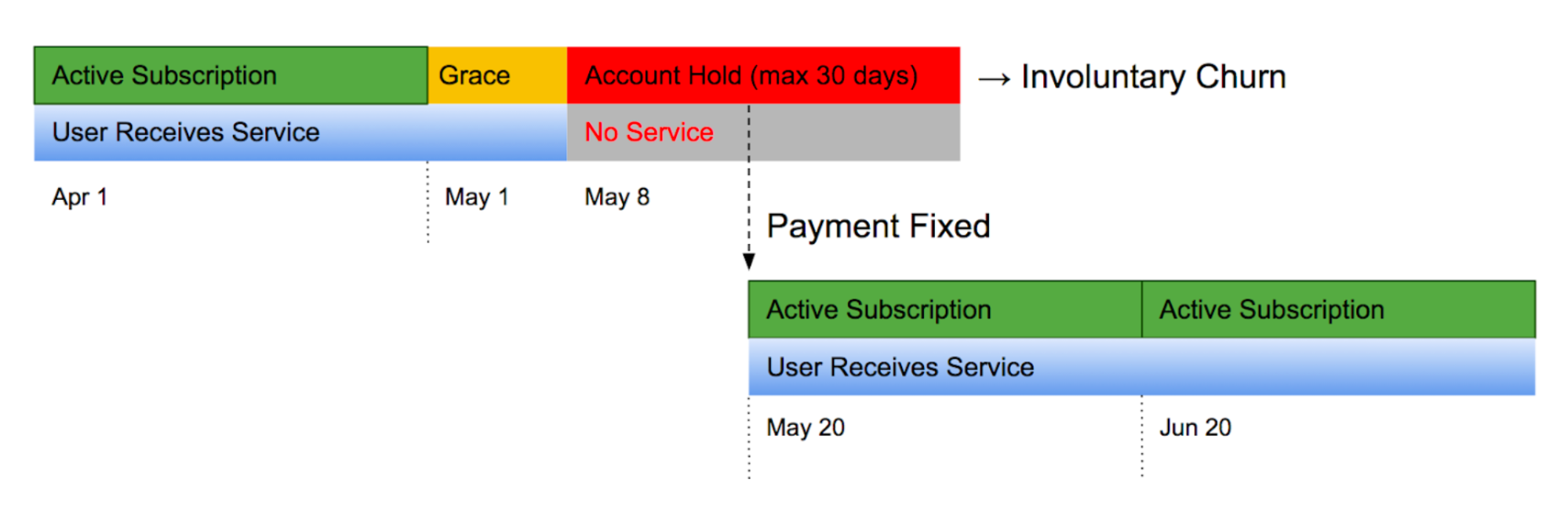
It is important to remember the following points:
- Before a subscription enters into account hold, Google Play makes additional attempts to charge the payment method for up to 48 hours. The user retains subscription benefits during this period. After this retry period has elapsed, the subscription then enters into account hold, and the user should lose access to subscription benefits.
- The subscription enters into account hold directly when the subscription resumes from a paused state with a failed form of payment.
- When a subscription recovers from account hold, the renewal date resets.
Expirations
Once a subscription expires, the user should lose access to the subscription. A
SubscriptionNotification message with type SUBSCRIPTION_EXPIRED is sent in
that case. When you receive this notification, query the Google Play Developer
API to get the latest subscription
resource.
After you confirm that the subscriptionState is SUBSCRIPTION_STATE_EXPIRED,
remove the entitlement and register the purchase state as invalid in your
backend. The subscription resource looks similar to the following example:
{
"kind": "androidpublisher#subscriptionPurchaseV2",
...
"subscriptionState": "SUBSCRIPTION_STATE_EXPIRED",
...
"lineItems": [
{
"productId": "sub_variant_plan01",
"expiryTime": expiration_time_in_past,
...
}
],
}
Cancellations
A user can voluntarily cancel a subscription from the Play subscriptions center
or have their subscription automatically canceled if they don't recover after
being in account hold. Developers can also trigger a
cancellation with
purchases.subscriptionsv2.cancel
When a subscription is canceled, the user retains access to the content until
the end of the current billing cycle. When the billing cycle ends, access should
be revoked.
Canceling a non-installment, auto-renewing subscription triggers a
SUBSCRIPTION_CANCELED notification. When
you receive this notification, the subscription
resource
returned from the Google Play Developer API has the subscriptionState field
set to SUBSCRIPTION_STATE_CANCELED, and the expiryTime field contains the
date when the user should lose access to the subscription. If that date is in
the past, then the user should lose entitlement immediately. This could happen,
for example, if a user cancels a subscription while on account
hold due to a payment decline.
The subscription resource for a canceled purchase looks similar to the following example:
{
"kind": "androidpublisher#subscriptionPurchaseV2",
...
"subscriptionState": "SUBSCRIPTION_STATE_CANCELED",
...
"lineItems": [
{
"productId": "sub_variant_plan01",
"expiryTime": expiration_time,
...
}
],
}
For installment subscriptions, a SUBSCRIPTION_CANCELLATION_SCHEDULED
notification gets sent upon a user-initiated cancellation when payments remain
for the commitment period. The cancellation is pending and takes effect at the
end of the current commitment period. When you receive this notification, the
subscription resource returned from the Google Play Developer API has the
subscriptionState field set to SUBSCRIPTION_STATE_ACTIVE because the
installment subscription is still active until the end of the commitment period.
However, there is an empty pendingCancellation object present.
A SUBSCRIPTION_CANCELED notification gets sent followed by a
SUBSCRIPTION_EXPIRED at the end of the commitment period.
The subscription resource for a installment subscription purchase that is pending cancellation looks similar to the following example:
{
"kind": "androidpublisher#subscriptionPurchaseV2",
...
"subscriptionState": "SUBSCRIPTION_STATE_ACTIVE",
...
"lineItems": [
{
"productId": "sub_plan01",
"expiryTime": expiration_time,
"autoRenewingPlan": {
"autoRenewEnabled": true,
"recurringPrice": {
"currencyCode": "USD",
"units": "1",
"nanos": 990000000
},
"installmentDetails": {
"initialCommittedPaymentsCount": 6,
"remainingCommittedPaymentsCount": 5,
"pendingCancellation": {}
...
}
}
}
],
}
You can look at the canceledStateContext field in the subscription resource to
learn why the subscription was canceled (for example, whether the subscription
was canceled by the user, by the system, or by you). If the subscription was
canceled by the user, you can look at the userInitiatedCancellation field to
learn why the user canceled the subscription. This can help inform communication
strategies.
When a subscription is canceled but has not yet expired, it is
still returned from
queryPurchasesAsync().
You might want to display a message in your app informing the user that their
subscription was canceled and giving them the date of expiration.
Revocations
A subscription can be revoked for a variety of reasons, including your backend
revoking the subscription by using
purchases.subscriptionsv2.revoke
or the purchase being charged back. In this situation, revoke the user's
entitlement immediately. A SubscriptionNotification message with type
SUBSCRIPTION_REVOKED is sent when this occurs. When you receive this
notification, the subscription
resource
returned from the Google Play Developer API has the subscriptionState field
set to SUBSCRIPTION_STATE_EXPIRED.
The subscription resource for a revoked purchase looks similar to the following example:
{
"kind": "androidpublisher#subscriptionPurchaseV2",
...
"subscriptionState": "SUBSCRIPTION_STATE_EXPIRED",
...
"lineItems": [
{
"productId": "sub_variant_plan01",
"expiryTime": expiration_time,
...
}
]
}
Deferred subscriptions
There are a variety of reasons why you might want to extend a user's
entitlement. For example, you might want to offer users free access as a special
promotion, such as giving one week free for purchasing a movie or providing free
access to customers as a gesture of goodwill. You can use the
purchases.subscriptions.defer
method from the Play Developer API to advance the next bililng date for an
auto-renewing subscription. When you do this, a SubscriptionNotification
message with type SUBSCRIPTION_DEFERRED is sent. During the deferral period,
the user is subscribed to your content with full access but is not charged. The
subscription renewal date is updated to reflect the new date.
For prepaid plans, you can use the defer billing API to defer the expiration time.
The subscription resource for a deferred subscription looks similar to the following example:
{
"kind": "androidpublisher#subscriptionPurchaseV2",
...
"subscriptionState": "SUBSCRIPTION_STATE_ACTIVE",
...
"lineItems": [
{
"productId": "sub_variant_plan01",
"expiryTime": timestamp_in_future,
...
}
],
}
Paused subscriptions
You can reduce voluntary churn by enabling users to pause their subscription. When you enable the pause feature, users can choose to pause their subscription for a period of time between one week and three months, depending on the recurring period. This temporarily suspends the subscription.
| Subscription recurrence | Weekly | Monthly | Three-month | Six-month | Annual |
|---|---|---|---|---|---|
| Available pause lengths* | 1 week 2 weeks 3 weeks 4 weeks |
1 month 2 months 3 months |
1 month 2 months 3 months |
1 month 2 months 3 months |
N/A |
A subscription pause takes effect only after the current billing period ends. While the subscription is paused, the user doesn't have access to the subscription, and they don't pay the renewal price. At the end of the pause period, the subscription resumes and Google attempts to renew the subscription. If the resume is successful, the subscription becomes active again. If the resume fails due to a payment issue, the user enters the account hold state as shown in figures 5 and 6:
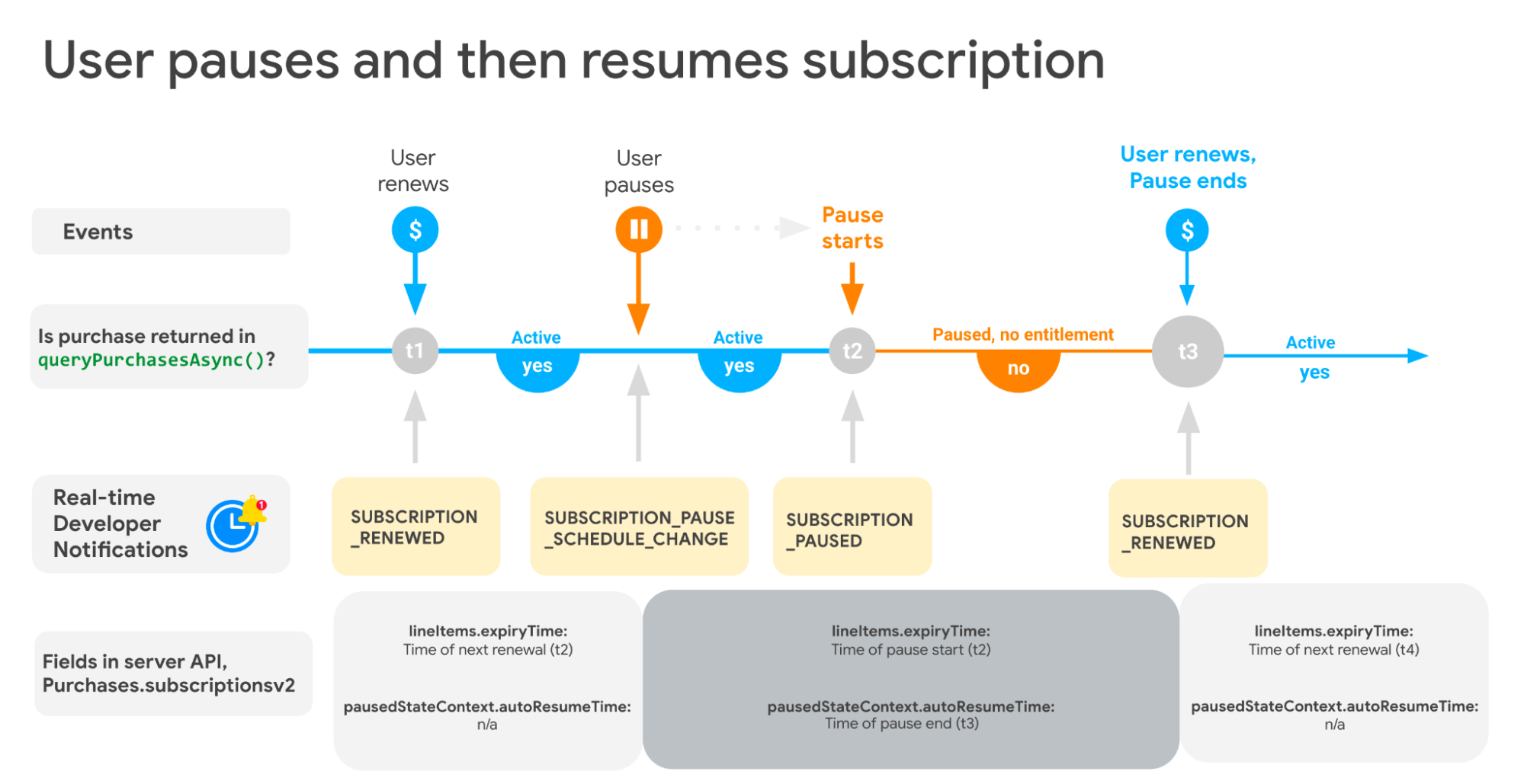
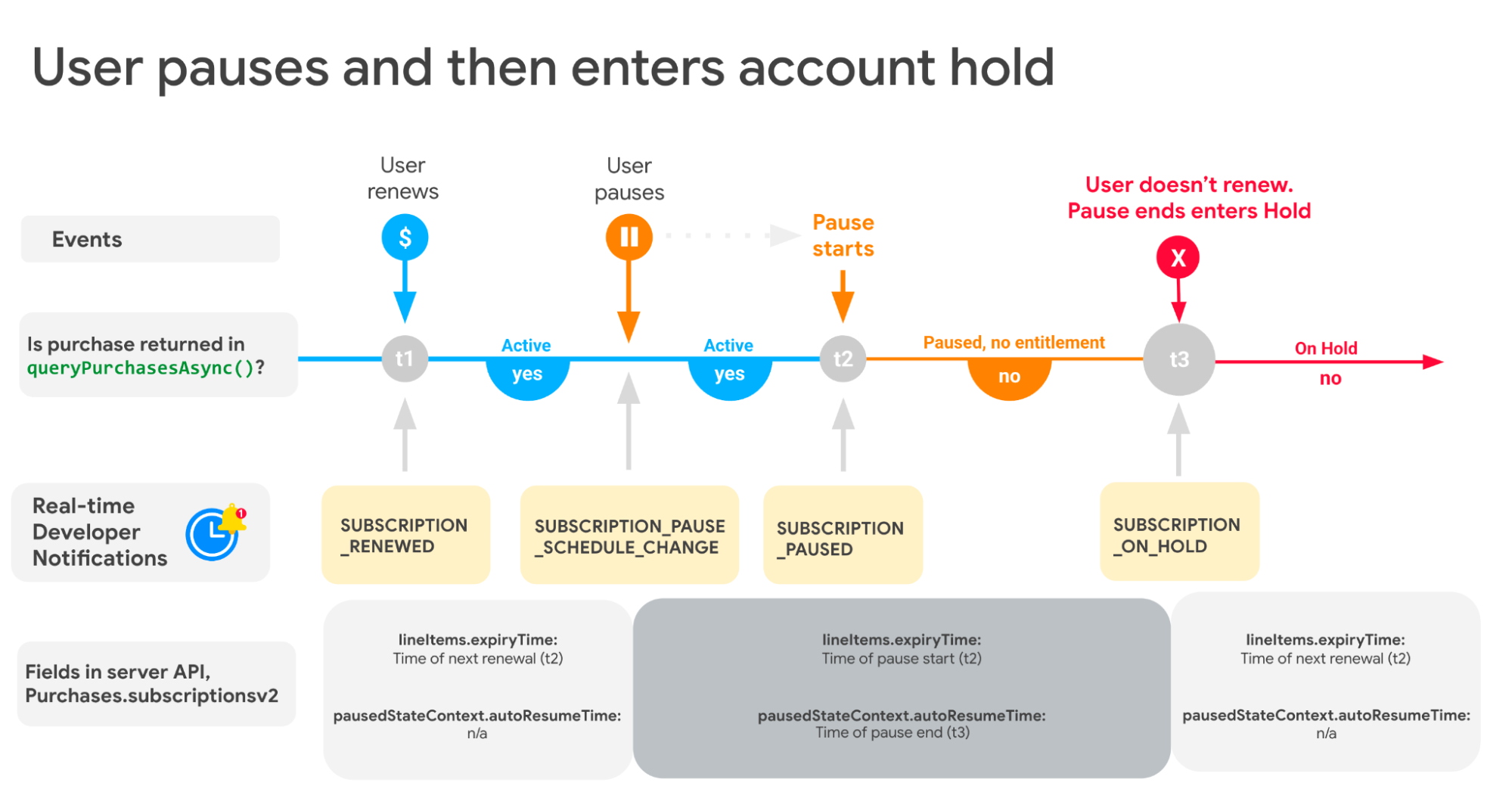
A user can also choose to manually resume a subscription at any time during the pause period, as shown in figure 6. When a user resumes manually, the billing date changes to the manual resume date.
When a user's subscription is paused, the Play Billing Library doesn't return
the subscription through the queryPurchasesAsync() method unless the
includeSuspendedSubscriptions parameter is set to true in the
QueryPurchasesParams. If the subscription is resumed, the
queryPurchasesAsync() method returns it again.
Listen for RTDNs to be aware of when a user pauses their subscription. These notifications also allow you to notify your users in your app that they have paused their subscription and don't have access to it. You should also provide a way for the user to manually resume their subscription at any time by using a deep link to Google Play.
A SubscriptionNotification message
with type SUBSCRIPTION_PAUSE_SCHEDULE_CHANGED is sent when your user initiates
a pause of their subscription. At this time, the user should keep access to
their subscription until the next renewal date, and the subscription
resource
contains autoRenewEnabled = true. The value of the subscriptionState field
is SUBSCRIPTION_STATE_ACTIVE at this point.
A SubscriptionNotification message with type SUBSCRIPTION_PAUSED is sent when the
pause goes into effect. When this happens, the user should lose access to their
subscription, and the subscription resource contains autoRenewEnabled = true,
and the subscriptionState field is set to SUBSCRIPTION_STATE_PAUSED. You can
see when the subscription is expected to renew again by checking the
PausedStateContext
object.
A SubscriptionNotification message with type SUBSCRIPTION_RECOVERED is sent if
the subscription is resumed either automatically at the end of the pause period
or if the user chose to manually resume the subscription.
A SubscriptionNotification message with type SUBSCRIPTION_ON_HOLD is sent if
there was a payment failure while trying to resume the subscription after pause.
Both situations should be handled as described in Account hold.
Resubscribe
For auto-renewing subscription base plans, the Google Play Store may display a Resubscribe button. This button allows users to regain access to a subscription. It may not appear for various reasons, for example when a subscription expired a long time ago.
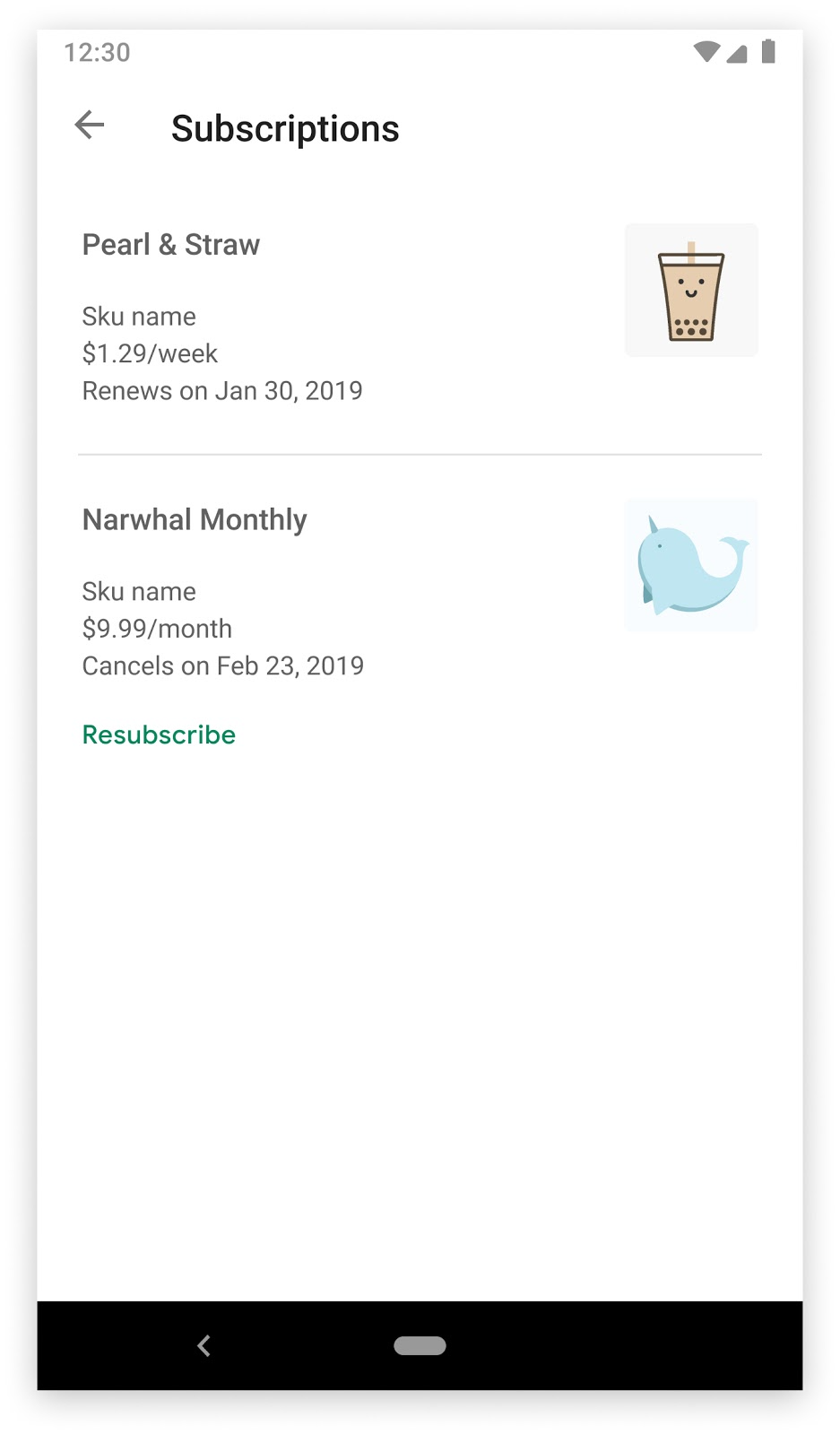
Although the button is always labeled Resubscribe, its functionality depends upon the subscription state.
While a subscription is canceled but not yet expired, the user is still subscribed and receiving subscription benefits. If the user taps Resubscribe, the cancelation is effectively undone, and the subscription continues to renew. This action is known as restore in Play developer documentation and APIs.
After an auto-renewing subscription has expired, you can allow users to purchase the same subscription base plan. This action is known resubscribe in Play developer documentation and APIs. You can configure this option for each base plan in the Play Console or using the API.
Restore prior to expiration
If your app relies solely on the
queryPurchasesAsync()
method to determine whether a user is entitled to a subscription, then your app
should automatically handle restorations because the queryPurchasesAsync()
method continues to return canceled purchases before their expiration dates. A
restored subscription continues to renew as if it were not canceled.
If your app synchronizes subscription state with a backend, you should listen
for a SubscriptionNotification
message with the type SUBSCRIPTION_RESTARTED. After you receive this RTDN,
your app can respond to the notification, record that the subscription is now
set to renew, and stop displaying restoration messages in your app. The
subscription resource looks similar to the following example:
{
"kind": "androidpublisher#subscriptionPurchaseV2",
...
"subscriptionState": "SUBSCRIPTION_STATE_ACTIVE",
...
"lineItems": [
{
"productId": "sub_variant_plan01",
"expiryTime": next_renewal_date
...
}
],
}
Resubscribe after expiration
If an auto-renewing base plan is configured using the Google Play Console or API to allow Resubscribe, users can re-purchase an expired subscription in the Google Play Store.
These are new purchases. Google Play issues a brand new purchase token, and your
backend receives an RTDN with type SUBSCRIPTION_PURCHASED. The purchase status
for this type of out-of-app purchase does not include a linkedPurchaseToken
associated with the original purchase in that case, because the original
subscription expired completely.
To ensure accurate user association for the re-purchased subscriptions and prevent automatic refunds for unacknowledged purchases, you must acknowledge the re-purchase on your backend server:
Call
purchases.subscriptionsv2.getwith the new purchase token from the RTDN. The response for this type of out-of-app purchase includes theoutOfAppPurchaseContextfield, present exclusively for unacknowledged resubscription purchases. This field provides:expiredExternalAccountIdentifiers: AnExternalAccountIdentifiersobject containing theobfuscatedAccountIdandobfuscatedProfileIdfields that were configured for the previous expired subscription, if they were set.expiredPurchaseToken: The purchase token of the last expired subscription.
Use either of these identifiers to look up and link the new purchase to the correct user account in your backend.
Call
purchases.subscriptions.acknowledgeto acknowledge the purchase.- Optionally, you can send the user's
obfuscatedAccountIdandobfuscatedProfileIdif you had configured them usingsetObfuscatedAccountIdandsetObfuscatedProfileIdduring the in-app billing flow.
- Optionally, you can send the user's
This server-side approach lets you acknowledge the purchase within three days from the date of purchase, even if the user doesn't open your app.
Upgrades, downgrades, and resubscribe
When a user upgrades, downgrades, or signs up after cancellation from your app before the subscription expires, the old subscription is invalidated and a new subscription is created with a new purchase token.
In addition, the subscription
resource
returned from the Google Play Developer API contains a linkedPurchaseToken
field that indicates the old purchase from which the user upgraded, downgraded,
or resubscribed. You can use the purchase token in that field to look up the old
subscription and identify the existing user account so that you can associate
the new purchase with the same account.
Before offering upgrade, downgrade, or resubscribe options to a user in your app, you must acknowledge the existing subscription. Any plan change or resubscribe is blocked if the existing subscription is still pending acknowledgement.
If the user successfully purchases the upgrade, downgrade, or resubscribe, this is a new purchase which you must acknowledge. The recommended way to do this is to use the Google Play Developer API. The subscription resource looks similar to the following example:
{
"kind": "androidpublisher#subscriptionPurchaseV2",
...
"subscriptionState": "SUBSCRIPTION_STATE_ACTIVE",
"linkedPurchaseToken": old_purchase_token,
...
"lineItems": [
{
"productId": "sub_variant_plan01",
"expiryTime": next_renewal_date,
"autoRenewingPlan": {
"autoRenewEnabled": true
}
}
],
}
Price changes
See the price change best practices guide to learn about changing auto-renewing subscription prices and notifying users when appropriate.
When a price change is added and for any updates to the price change status,
you will receive the SUBSCRIPTION_PRICE_CHANGE_UPDATED RTDN. You can query
the purchases.subscriptionsv2.get endpoint to get a
subscription resource which will contain price change details for each item
in the subscription.
When price changes are applied to existing subscribers as opt-in, you will received an RTDN if the user takes action to confirm or reject the new price.
Handle user confirmation of an opt-in price change
When a user accepts your subscription price increase, you receive a
SubscriptionNotification message with type
SUBSCRIPTION_PRICE_CHANGE_UPDATED.
Handle renewals after price change is applied
With a price decrease, or when the subscription price increase renews,
you will receive a SubscriptionNotification message with type
SUBSCRIPTION_RENEWED. Treat this notification like any other renewal.
Handle cases where an opt-in price increase is not accepted
If a user hasn't accepted your opt-in price increase before they need
to renew at the higher price, they are automatically unsubscribed
and you receive a
SubscriptionNotification message
with type SUBSCRIPTION_CANCELED. Handle this event as described in
Cancellations.
Users can also cancel their subscriptions for an opt-out price increase following the same mechanism.
Price step-up consent (applicable only for KR region)
Due to new South Korean (KR) regulations, subscription users in the KR region must consent to any price step-ups that will occur after their free trial or introductory period ends.
To help you comply with the regulation, Play will notify users in the KR region about the consent requirement and will also store the consent response from the users. Subscriptions are automatically canceled for users who don't provide consent before the higher price takes effect. In addition to the notifications sent from Play, you can also send your custom price step-up notifications to your users, and can provide link to specific management page in your notifications.
When the consent period has begun or the user has provided
consent, you will receive a SubscriptionNotification message with type
SUBSCRIPTION_PRICE_STEP_UP_CONSENT_UPDATED.
Difference between price step-up and price change
A price step-up refers to an increase in the subscription price, due to a
transition from one offer phase to another. For
example, a subscription moving from a free trial to a regular price.
However, a price change refers to price updates initiated by you (developer)
for the base plan price for a subscription. For example,
opt-in price increase or opt-out price increase.
Handle lifecycle for prepaid plans
As with auto-renewing subscriptions, you must acknowledge prepaid plans after each new purchase. In the case of prepaid plans, you must fully process both the initial purchase and any top-ups, because the user has to go through the purchase flow every time.
Due to the potential for short prepaid plan durations, it's important to acknowledge the purchase as soon as possible. Prepaid plans with a duration of one week or longer must be acknowledged within 3 days. Prepaid plans with a duration shorter than one week must be acknowledged within half of the plan duration. For example, developers have 1.5 days to acknowledge purchase of a three-day prepaid plan.

A SubscriptionNotification message
with type SUBSCRIPTION_PURCHASED is sent to your RTDN client whenever a
prepaid plan subscription is purchased, including every top-up. Call the
purchases.subscriptionsv2.get
method to check for the latest prepaid plan subscription state.
A new purchase token is issued for top-up purchases, and you receive the
previous purchase token in the linkedPurchaseToken field as part of the new
subscription purchase state. The purchase token is valid from subscription
signup until 60 days after expiration. After this date, the purchase token is
no longer valid to use to call the Google Play Developer API.
The subscription resource for a prepaid plan purchase looks similar to the following example:
{
"kind": "androidpublisher#subscriptionPurchaseV2",
"startTime": "2022-04-22T18:39:58.270Z",
"regionCode": "US",
"subscriptionState": "SUBSCRIPTION_STATE_ACTIVE",
"latestOrderId": "GPA.3333-4137-0319-36762",
"acknowledgementState": "ACKNOWLEDGEMENT_STATE_ACKNOWLEDGED",
"lineItems": [
{
"productId": "prepaid_plan01",
"expiryTime": expiry_date,
"prepaidPlan": {
"allowExtendAfterTime": timestamp_after_which_topups_are_allowed
}
}
]
}
You can see when the entitlement ends in the expiryTime field. Top-up
purchases increase the entitlement time by accumulating it. That means that if
the user tops up before their original entitlement ends, the new time is added
on top of their previous expiration date.
You might want to display a message in your app informing the user that their
prepaid subscriptions can be extended with a top-up. To know when a user will be
able to top-up, check the allowExtendAfterTime field in the subscription
resource.
Prepaid plans don't auto-renew, so they can't be canceled. If a user wants to cancel a prepaid plan, they can let it reach its expiration date.
SubscriptionPurchaseV2 fields for prepaid plans
New fields have been added to support prepaid plans, which are extended by the user instead of automatically renewing. All fields apply to prepaid plans as they do for auto-renewing subscriptions, with the following exceptions:
- [New field] lineItems[0].prepaid_plan.allowExtendAfterTime: denotes when a user will be allowed to buy another top-up to extend their prepaid plan, as a user is allowed to have only one unconsumed top-up at a time.
- [New field] SubscriptionState: specifies the subscription object state.
For prepaid plans, this value is always either
ACTIVE,PENDING, orCANCELED. - lineItems[0].expiryTime: This field is always present for prepaid plans.
- paused_state_context: This field is never present, as prepaid plans cannot pause.
- lineItems[0].auto_renewing_plan: Not present for prepaid plans.
- canceled_state_context: Not present for prepaid plans, as this field applies only to users who actively cancel a subscription.
- lineItems[0].productId: This field replaces
subscriptionIdfrom previous versions.
